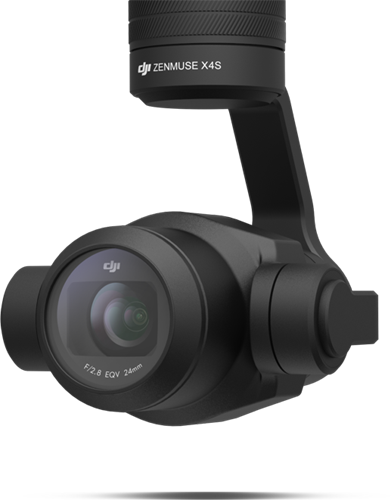
Do DJI know what they have with the X4s camera?
This little power house of a camera is a light weight version of the large aerial cameras carried in manned aircraft.
How do aerial or metric cameras differ to a DSLR? An aerial mapping camera is primarily designed to have a low distortion metric lens and reliable construction to maintain its calibration. To achieve this the cameras have very few moving parts, particularly those that would affect the lens focal length.
Aerial camera lenses are very high quality and virtually distortion free. This, and a constant lens focal length, mean that every pixel is in the right place. 3D mapping from photogrammetry is based on the position of each pixel, and a displaced pixel will mean a loss of accuracy in the model.
Though a lot of UAV operators carry DSLR cameras, such as the Sony alpha 7R or similar models, it isn’t necessarily the best choice for mapping from a drone. These are great cameras, high megapixel count, large sensor, they take beautiful photos. But every time you turn the camera on, you’ll hear the parts in the camera shuffling around, changing the calibration.
So what have DJI done with the X4s? No moving parts. The lens parts stay where they were built, enabling their calibration to be measured and those values to stay with the camera from project to project.
The X4s has a leaf shutter. Many drones carry a rolling shutter camera that scans the pixels onto the photo, introducing pixel shifts with the movement of the camera over the duration of the scan. A leaf shutter opens from the centre outwards and captures every pixel at the same instant.
A large sensor. For its size, the X4s sensor is large, 1”, enabling more data to be captured.
Carried on a DJI drone (M200, M210 or Inspire 2) we have a very nice package; reliable, economical, these popular drones are great flyers.
To complete the package, to be an incredible metric UAV camera, we need precise centre of exposure GPS timing. Klau Geomatics produce a calibrated X4s with a reliable, one millisecond centre of exposure pulse output. So, at 10 m/s flight speed the maximum relative geo-positioning error for each image will be 10mm.
This precise middle of exposure timing is then used in the KlauPPK hardware (powered by Novatel) and post-processing software to geotag each photo with accurate coordinates in any global or local coordinate system.
Each camera is supplied with a certificate of calibration. The accurate camera coordinates and calibrated camera parameters enable users to achieve unprecedented (better than 3cm) absolute geo-positioning accuracy, repeatable and reliable without any ground control points.
Of course we recommend you have some check points in the project, which can be captured with the drone, to prove just how good your mapping really is.
Find out more about the Klau Geomatics DJI X4s PPK system and how it can help your business at www.klauppk.com and contact the Klau Geomatics team, contact@geomatics.com.au


